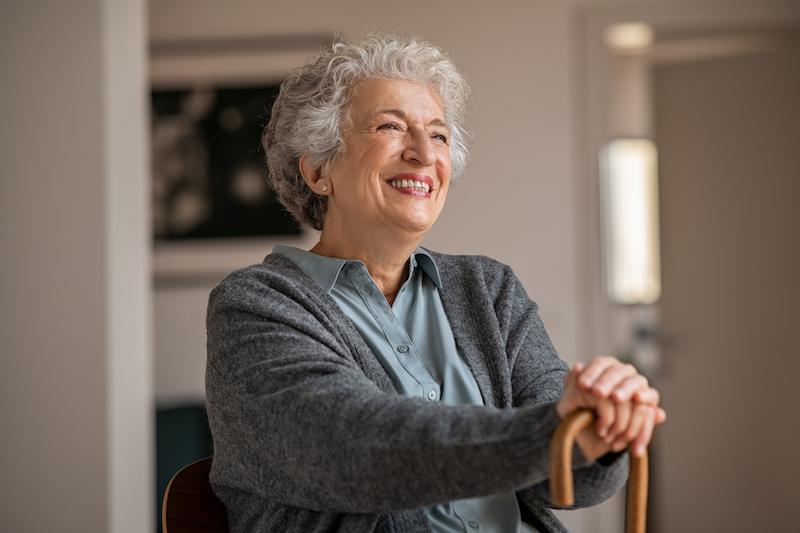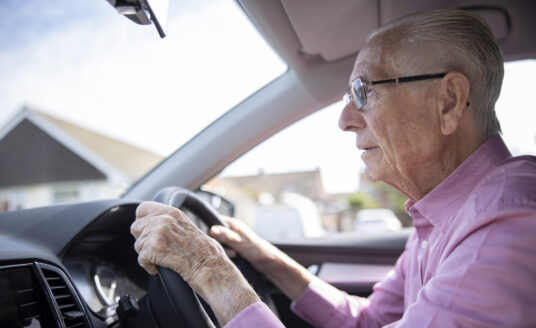Aside from aging, a number of factors can contribute to decreased mobility for seniors. These include:
- Obesity
- Vision problems
- Impaired strength
- Chronic diseases (like diabetes or arthritis)
- Recent hospitalization
Depression can also lead to mobility issues, as it saps a person’s willingness to stay physically active.
Inactivity and decreased mobility can adversely affect the mind and body of a senior. As abilities decrease and challenges with daily responsibilities increase, there’s a temptation for seniors to give up on activities. Not to mention, decreased mobility contributes to a higher risk for falls — which can lead to even more mobility issues.
Signs that mobility problems need to be addressed are:
- Difficulty walking or maintaining balance
- Repeated trips and falls
- Bouts of dizziness
- Problems reaching for items
- Struggling to get in and out of chairs
- Inability to safely use stairs
Fortunately, an ever-expanding array of aids and devices are available to help keep seniors active and moving.
Mobility Aids
Canes
The most common assistive device is the cane. They come in various designs:
- Self-standing models with widened bases or feet that keep the cane from falling over and provide more stability.
- Foldable canes that collapse for storage.
- Posture canes, which help the user walk more upright.
- The HurryCane, which is both a self-standing and foldable device.
- Forearm canes, which have an extension that takes some of the weight from the hands and wrist and transfers it to the arms.
Crutches
Crutches are used primarily for more severe but temporary mobility limitations. However, there are crutches that can be used more long-term. An example of this type of crutch is the Dynamo Sport Swings Lightweight Crutches, which features shock-resistance grip feet and an anti-slip back strap to keep the crutches from slipping out from under the senior.
Knee Scooters
These aids provide padded cushions for people suffering from lower leg or foot problems. Users elevate the affected leg by resting the knee on the cushion and propelling the scooter with the other leg. This lightweight, wheeled device — like this one from Vive Health — is adjustable for height and has its own braking system for safe stops.
Walkers
Walkers can come with no wheels, or wheels on the two front legs. There are also four-wheel walkers called rollators. Walkers provide more support and balance than canes and crutches, but they can be difficult to maneuver — particularly outside the home. For example, the NOVA Vibe 6 Rollator Walker comes with hand brakes, a seat to rest on, a storage pouch, 300-lb. carrying capacity, and can be adjusted for height.
Wheelchairs
Wheelchairs, particularly electric wheelchairs, provide mobility for people who cannot walk or put weight on their lower body.
Choosing which electric wheelchair to buy can be a big decision. Mobility Deck has reviewed dozens of electric wheelchairs to identify the best of the best for 2021 in their guide to electric wheelchairs.
Mobility scooters
Similar to wheelchairs but bulkier, battery-powered mobility scooters work well outdoors.
Ramps
Ramps are good for seniors who have trouble negotiating stairs, and work particularly well with older adults in wheelchairs or on mobility scooters.
Other Mobility Aids and Resources
There are many other devices that help seniors with decreased mobility:
- Reaching aids to assist in retrieving items that may be out of the senior’s reach.
- Stair lifts that can restore the use of an upper or lower floor in the home.
- Handrails and grab bars, which can decrease the chances of a fall.
There is a wide range of other devices that can help seniors — including recliner lift chairs, elevated toilet seats with arms, shower chairs, and transfer benches.
Finding and removing fall hazards in the senior’s home will also help, as will installing night lights to make moving about the house in the dark safer.
Occupational therapists can teach seniors exercise and rehabilitation techniques to help complete daily tasks like dressing, eating, and bathing. They can also provide information and training with the assistive devices the senior may need.
With all that is available to assist seniors and the importance seniors place on living independently, it is worth researching. Good luck!
Take a look at our blog for more resources on senior health concerns.
| Bethesda has a 133-year tradition of providing excellent senior living options, including independent living, assisted living, memory care, and skilled nursing. If you are considering independent living, we welcome you to tour one of our exceptional communities, including Bethesda Barclay House – Clayton, Bethesda Gardens – Kirkwood, Bethesda Orchard – Webster Groves, Bethesda Terrace – South County, Village North Retirement Community – Florissant, and The Oaks at Bethesda Villas – Kirkwood/Webster. Discover the level of care only a non-profit staffed by highly-trained nurses, therapists, and aids can offer. |



